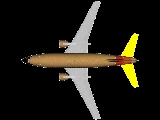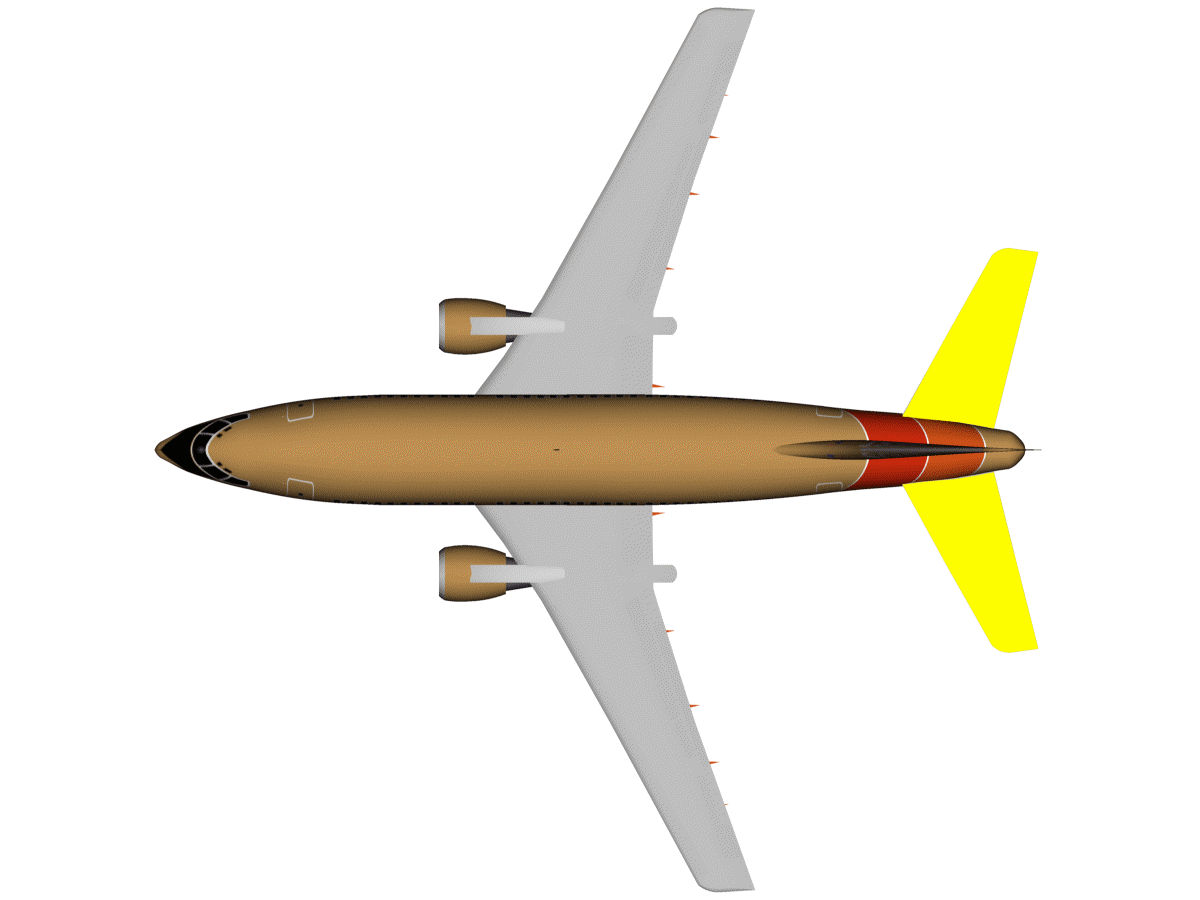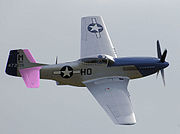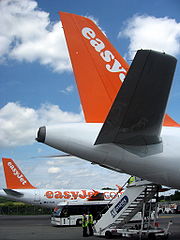
Tailplane
Encyclopedia

Stabilizer (aircraft)
In aviation, a stabilizer provides stability when the aircraft is flying straight, and the airfoil of the horizontal stabilizer balances the forces acting on the aircraft....
(or horizontal stabiliser), is a small lifting
Lift (force)
A fluid flowing past the surface of a body exerts a surface force on it. Lift is the component of this force that is perpendicular to the oncoming flow direction. It contrasts with the drag force, which is the component of the surface force parallel to the flow direction...
surface located on the tail (empennage
Empennage
The empennage , also known as the tail or tail assembly, of most aircraft gives stability to the aircraft, in a similar way to the feathers on an arrow...
) behind the main lifting surfaces of a fixed-wing aircraft
Fixed-wing aircraft
A fixed-wing aircraft is an aircraft capable of flight using wings that generate lift due to the vehicle's forward airspeed. Fixed-wing aircraft are distinct from rotary-wing aircraft in which wings rotate about a fixed mast and ornithopters in which lift is generated by flapping wings.A powered...
as well as other non-fixed wing aircraft such as helicopter
Helicopter
A helicopter is a type of rotorcraft in which lift and thrust are supplied by one or more engine-driven rotors. This allows the helicopter to take off and land vertically, to hover, and to fly forwards, backwards, and laterally...
s and gyroplanes. However, not all fixed-wing aircraft have tailplanes, such as those configured with canard
Canard (aeronautics)
In aeronautics, canard is an airframe configuration of fixed-wing aircraft in which the forward surface is smaller than the rearward, the former being known as the "canard", while the latter is the main wing...
s (where the "tail-plane" is located in front), flying-wing aircraft, where there is no tail, and v-tail
V-tail
In aircraft, a V-tail is an unconventional arrangement of the tail control surfaces that replaces the traditional fin and horizontal surfaces with two surfaces set in a V-shaped configuration when viewed from the front or rear of the aircraft...
aircraft where the fin/rudder and tail-plane are combined to form two diagonal surfaces in a V layout. The tailplane serves three purposes: equilibrium, stability and control.
Tailplanes
The tailplane comprises the tail-mounted fixed horizontal stabiliser and movable elevator. Besides its planform, it is characterised by:- Number of tailplanes - from 0 (taillessTailless aircraftA tailless aircraft traditionally has all its horizontal control surfaces on its main wing surface. It has no horizontal stabilizer - either tailplane or canard foreplane . A 'tailless' type usually still has a vertical stabilising fin and control surface...
or canard) to 3 (Roe triplane) - Location of tailplane - mounted high, mid or low on the fuselage, fin or tail booms.
- Fixed stabilizer and movable elevator surfaces, or a single combined stabilatorStabilatorA stabilator is an aircraft control surface that combines the functions of an elevator and a horizontal stabilizer...
or flying tail. (General Dynamics F-111General Dynamics F-111The General Dynamics F-111 "Aardvark" was a medium-range interdictor and tactical strike aircraft that also filled the roles of strategic bomber, reconnaissance, and electronic warfare in its various versions. Developed in the 1960s by General Dynamics, it first entered service in 1967 with the...
)
Some locations have been given special names:
- Cruciform: mid-mounted on the fin (Hawker Sea HawkHawker Sea HawkThe Hawker Sea Hawk was a British single-seat jet fighter of the Fleet Air Arm , the air branch of the Royal Navy , built by Hawker Aircraft and its sister company, Armstrong Whitworth Aircraft. Although its origins stemmed from earlier Hawker piston-engined fighters, the Sea Hawk became the...
, Sud Aviation CaravelleSud Aviation CaravelleThe Sud Aviation SE 210 Caravelle was the first short/medium-range jet airliner produced by the French Sud Aviation firm starting in 1955 . The Caravelle was one of the more successful European first generation jetliners, selling throughout Europe and even penetrating the United States market, with...
) - T-tailT-tailthumb|right|Grob motor gliderA T-tail is an aircraft tail stabilizer configuration in which the horizontal surfaces are mounted to the top of the vertical stabilizer. Traditionally, the horizontal control surfaces are mounted to the fuselage at the base of the vertical stabilizer...
: high-mounted on the fin (Gloster JavelinGloster JavelinThe Gloster Javelin was an "all-weather" interceptor aircraft that served with Britain's Royal Air Force in the late 1950s and most of the 1960s...
, Boeing 727Boeing 727The Boeing 727 is a mid-size, narrow-body, three-engine, T-tailed commercial jet airliner, manufactured by Boeing. The Boeing 727 first flew in 1963, and for over a decade more were built per year than any other jet airliner. When production ended in 1984 a total of 1,832 aircraft had been produced...
)
Fuselage mounted |
Cruciform |
T-tail |
Flying tailplane |
Equilibrium

Force
In physics, a force is any influence that causes an object to undergo a change in speed, a change in direction, or a change in shape. In other words, a force is that which can cause an object with mass to change its velocity , i.e., to accelerate, or which can cause a flexible object to deform...
s acting on the aeroplane produces no overall pitching moment
Pitching moment
In aerodynamics, the pitching moment on an airfoil is the moment produced by the aerodynamic force on the airfoil if that aerodynamic force is considered to be applied, not at the center of pressure, but at the aerodynamic center of the airfoil...
about the centre of gravity.
In a conventional aircraft, the center of gravity is ahead of the center of lift, which would cause the aircraft to pitch forward without the downward force of the tailplane to balance this. In cases where the two forces are close together, the control inputs required to fly the aircraft may be to difficult to apply precisely enough for many pilots to maintain control of the aircraft.
Examples of aircraft that had this setup include Charles Lindbergh
Charles Lindbergh
Charles Augustus Lindbergh was an American aviator, author, inventor, explorer, and social activist.Lindbergh, a 25-year-old U.S...
's Spirit of St. Louis
Spirit of St. Louis
The Spirit of St. Louis is the custom-built, single engine, single-seat monoplane that was flown solo by Charles Lindbergh on May 20–21, 1927, on the first non-stop flight from New York to Paris for which Lindbergh won the $25,000 Orteig Prize.Lindbergh took off in the Spirit from Roosevelt...
, the Sopwith Camel
Sopwith Camel
The Sopwith Camel was a British First World War single-seat biplane fighter introduced on the Western Front in 1917. Manufactured by Sopwith Aviation Company, it had a short-coupled fuselage, heavy, powerful rotary engine, and concentrated fire from twin synchronized machine guns. Though difficult...
and the Gee Bee R Racer - all aircraft with a reputation for being difficult to fly.
With computer controls this is no longer a problem and aircraft as different as the Airbus and the F-16 are flown in this condition. The advantage to this is a significant reduction in induced drag caused by the tailplane, and in the case of the F-16, improved maneuverability.
In addition the tailplane helps adjust for changes in the center of lift, and center of gravity caused by changes in speed and attitude, or when fuel is burned off, or when cargo or payload is dropped from the aircraft.
Not all aircraft have tailplanes - the downward force is instead provided by the trailing edge of the wing on straight wing flying wings such as the Fauvel AV.36
Fauvel AV.36
-References:* * -External Links:*...
and by the wingtips on swept wing flying wings. In both cases, because the force being applied is acting on a short moment arm, the forces must be larger, which incurrs a larger induced drag penalty that may outweigh the reduction in weight the lack of a fuselage brings, particularly for larger aircraft where weight is less critical than drag.
On some airplanes built before World War I
World War I
World War I , which was predominantly called the World War or the Great War from its occurrence until 1939, and the First World War or World War I thereafter, was a major war centred in Europe that began on 28 July 1914 and lasted until 11 November 1918...
, such as the Bleriot XI
Blériot XI
The Blériot XI is the aircraft in which, on 25 July 1909, Louis Blériot made the first flight across the English Channel made in a heavier-than-air aircraft . This achievement is one of the most famous accomplishments of the early years of aviation, and not only won Blériot a lasting place in...
, the center of gravity is between the center of lift from the wings, and the tailplane, which instead of providing a downward force, provided an upward one, however there are severe handling issues with this arrangement that were beyond the capabilities of designers at the time to fix, so the layout was abandoned.
Stability
An aeroplane with a wing not designed to work independently of a tailplane is normally unstable in pitch (longitudinal instabilityPitching moment
In aerodynamics, the pitching moment on an airfoil is the moment produced by the aerodynamic force on the airfoil if that aerodynamic force is considered to be applied, not at the center of pressure, but at the aerodynamic center of the airfoil...
). This means that any disturbance (such as a gust) which raises the nose produces a nose-up pitching moment which tends to raise the nose further. With the same disturbance, the presence of a tailplane produces a restoring nose-down pitching moment which counteracts the natural instability of the wing and makes the aircraft longitudinally stable - much the same way a windvane always points into the wind. A stable aeroplane can be flown "hands-off" and will not depart significantly from its airspeed
Airspeed
Airspeed is the speed of an aircraft relative to the air. Among the common conventions for qualifying airspeed are: indicated airspeed , calibrated airspeed , true airspeed , equivalent airspeed and density airspeed....
and pitch attitude. Aircraft which have the center of gravity and centre of lift close together are considered to be unstable or having relaxed stability. Using a computer to control the elevator allows these aircraft to be flown in the same manner.

Relative wind
In aeronautics, the relative wind is the direction of movement of the atmosphere relative to an aircraft or an airfoil. It is opposite to the direction of movement of the aircraft or airfoil relative to the atmosphere...
seen by the tail as the aircraft rotates around the center of mass. For example when the aircraft is oscillating, but is momentarily aligned with the overall vehicle's motion, the tailplane still sees a relative wind that is opposing the oscillation.
Control
-
- Elevator
A tailplane has a hinged surface called an elevator
Elevator (aircraft)
Elevators are flight control surfaces, usually at the rear of an aircraft, which control the aircraft's orientation by changing the pitch of the aircraft, and so also the angle of attack of the wing. In simplified terms, they make the aircraft nose-up or nose-down...
, which allows the pilot
Aviator
An aviator is a person who flies an aircraft. The first recorded use of the term was in 1887, as a variation of 'aviation', from the Latin avis , coined in 1863 by G. de la Landelle in Aviation Ou Navigation Aérienne...
to control the amount of lift produced by the tailplane. This in turn causes a nose-up or nose-down pitching moment on the aircraft, which is used to control the aircraft in pitch.
-
- All-moving tail
In transonic
Transonic
Transonic speed is an aeronautics term referring to the condition of flight in which a range of velocities of airflow exist surrounding and flowing past an air vehicle or an airfoil that are concurrently below, at, and above the speed of sound in the range of Mach 0.8 to 1.2, i.e. 600–900 mph...
flight, however, shock wave
Shock wave
A shock wave is a type of propagating disturbance. Like an ordinary wave, it carries energy and can propagate through a medium or in some cases in the absence of a material medium, through a field such as the electromagnetic field...
s generated by the tailplane render the elevator unusable. An all-moving tail was developed by the British for the Miles M.52
Miles M.52
The Miles M.52 was a turbojet powered supersonic research aircraft project designed in the United Kingdom in the mid 1940s. Design work was undertaken in secrecy between 1942 and 1945. In 1946 the Air Ministry prudently but controversially changed the project to a series of unmanned rocket-powered...
, but first saw actual transonic flight on the Bell X-1
Bell X-1
The Bell X-1, originally designated XS-1, was a joint NACA-U.S. Army/US Air Force supersonic research project built by Bell Aircraft. Conceived in 1944 and designed and built over 1945, it eventually reached nearly 1,000 mph in 1948...
; fortunately, although the tailplane was conventional in design, Bell Aircraft Corporation had included an elevator trim device that could alter the angle of attack
Angle of attack
Angle of attack is a term used in fluid dynamics to describe the angle between a reference line on a lifting body and the vector representing the relative motion between the lifting body and the fluid through which it is moving...
of the entire tailplane. This saved the program from a costly and time-consuming rebuild of the aircraft.
Transonic and supersonic aircraft now have all-moving tailplanes to counteract the Mach tuck
Mach tuck
Mach tuck is an aerodynamic effect, whereby the nose of an aircraft tends to pitch downwards as the airflow around the wing reaches supersonic speeds...
and maintain maneuverability when flying faster than the critical Mach number
Critical Mach number
In aerodynamics, the critical Mach number of an aircraft is the lowest Mach number at which the airflow over any part of the aircraft reaches the speed of sound....
. While technically called a stabilator
Stabilator
A stabilator is an aircraft control surface that combines the functions of an elevator and a horizontal stabilizer...
, this configuration is often referred to as an "all-moving" or "all-flying" tailplane.

